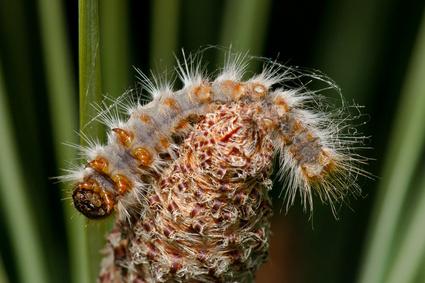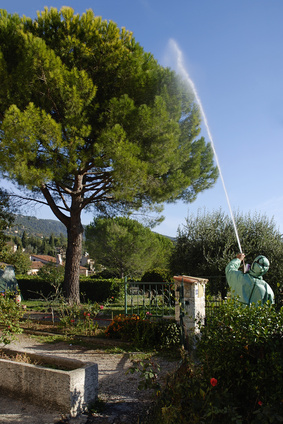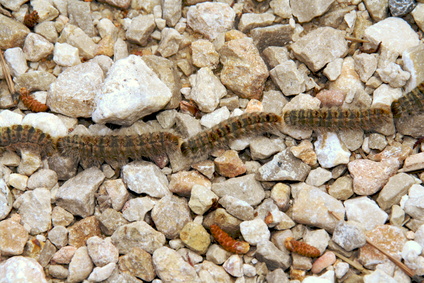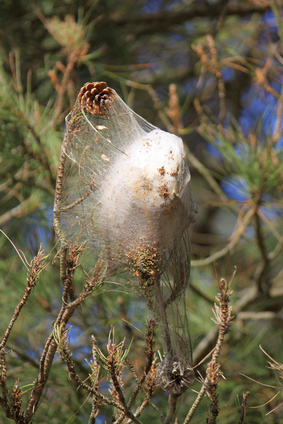 Pine processionary (thaumetopoea pityocampa) is a responsible for envenomations in our domestic carnivores. Pine processionary (thaumetopoea pityocampa) is a responsible for envenomations in our domestic carnivores.
It is found in the regions to the favourable climatetheir development (they are mainly found on the Mediterranean coast, in Corsica and on the Atlantic coast) and spiny-rich (the larvae feed in fact various kinds of pine needles).
The dog is more concerned with such envenomation because it is less suspicious than the cat and place all sorts of objects into his mouth.
TERMS OF THE ENVENOMATION
¤ Scorpion occurs essentially to the end of winter and to the beginning of Spring: caterpillars then descend from the pines and move down in Indian file before bury to make a cocoon and turn into pupa.
¤ The dog comes in contact with the toxin:
– either directly: the dog licks a caterpillar and thus breaks the stinging hairs she wears on the back, releasing the toxin (thaumatopoeine) they contain
– either indirectly: by contact with a nest fell down or simple inhalation of hairs transported in the air during high winds.
SYMPTOMS OF ENVENOMATION
Envenomation symptoms result from the inoculation of the venom contained in stinging hairs through the skin or the mucous membranes of the animal concerned.
The thaumatopoeine may be responsible for local lesions (at the level of the contact area between the stinging hairs and skin or the mucous membranes of the animal) but also of general symptoms.
¤ Local lesions
– Ocular lesions: When contact between the stinging hairs and eyes, conjunctivitis or corneal ulcers may appear. An ophthalmic examination must therefore be practiced against any suspicion of envenomation by des chenilles processionnaires.
– Skin lesions: the thaumatopoeine can cause the appearance of significant skin lesions, especially on the edges of the lips and all areas where the skin is fine.
– Oral and gastrointestinal lesions: A few minutes to a few hours after contact between a caterpillar and the animal's mouth, very important inflammation. The dog suffers from itching, It happens more swallowing and starts salivating enormously. His face swollen and his language which becomes gradually. Ulcers can then widen. A few days after envenomation, the death of part of the language having been in contact with the stinging hairs can occur: the area concerned will blacken and then detach from the healthy part. These lesions are especially marked that the area of contact between the stinging hairs and mucous membranes has been important.
If caterpillars have swallowed, the inflammation will also affect the esophagus and the stomach of the animal. Vomiting may occur.
¤ General disorders
These local symptoms might be added to General disorders related to a direct action of the thaumatopoeine on the major functions of the organism or resulting from injury to local.
– The animal is very often feverish (hyperthermia at 40 °)
– The swelling of the tongue and the back of throat can cause a severe respiratory distress.
– Coagulation disorders are sometimes noted with onset of a very large haemorrhagic risk.
– Scorpion can cause a renal failure
– Finally, one Allergic shock can occur as well as convulsions or coma.
The various complications associated with envenomation may lead to the death of the animal.
The prognosis of the animal depends on two factors:
– The quick response After envenomation for against the overall impact: oxygenation respiratory distress, fight against kidney disease, treatment of disorders of coagulation…
– The severity of local lesions (which can be assessed only after a few days). Indeed, in case of contact with the toxin, Some animals lose much of their language, What makes any very difficult food intake.
TREATMENT
As we have just raise it, rapid intervention and implementation of treatment will play a large role in prognosis.
If you suspect your pet hit processionnaires caterpillars, better do not handle: the stinging hairs of des chenilles processionnaires behave like tiny harpoons that plant in mucous membranes. Any friction will increase the release of thaumatopoeine, worsening symptoms.
It should be, Furthermore, avoid contact of your skin with stinging hairs because the toxin causes also skin lesions in humans.
It is necessary tovisit your vet as soon as possible where various treatments will be performed on the basis of the symptoms.
– The urgency is theoxygenation of the animal in the event of edema of throat to avoid choking
– The veterinarian will then Rinse the jaws of the dog with a solution to eliminate without breaking a maximum of stinging hairs and the toxin they contain (thereby limiting local lesions and the overall impact by reducing the portion of the toxin in the blood).
– An injection of Cortisone is practiced by the veterinarian to combat swelling and inflammation
– Appropriate treatment is set up to deal with possible kidney or Hemorrhagic Disorders.
– The administration of antacid and gastrointestinal dressings to limit digestive disorders associated with ingestion of a caterpillar.
– If the animal is unable to eat after a long time (due to a mechanical gene related to edema of the language or a very significant pain…), the veterinarian may, If he deems it necessary, decide to put in place a probe of recharge.
PREVENTION OF ENVENOMATIONS
Prevention against any contact with des chenilles processionnaires pine is paramount because there is No "of antitoxin" active against the thaumatopoeine.
In addition, humans are also susceptible to Scorpion. Contact with the toxin occurs:
either directly (inhalation of hair, ingestion of a caterpillar by a child),
or indirectly (contact with remnants of stinging spines when an affected dog care).
Itching and the plates like nettle stings then appear at the level areas of contact with the stinging hairs (the hands most often). Allergic shock have also been described in humans.
The prevention of the envenomation occurs at several levels:
– By the destruction of eggs:
During the summer, the bearing sleeves of eggs can be eliminated.
– By the destruction of larvae: 
In the areas concerned, the municipality usually makes an annual salary to limit the progression of these butterflies.
Biological control is preferred: a bacterium (Bacillus thuringiensis) is sprayed onto the trees at the end of l&Ambiente |
 Pine processionary (thaumetopoea pityocampa) is a responsible for envenomations in our domestic carnivores.
Pine processionary (thaumetopoea pityocampa) is a responsible for envenomations in our domestic carnivores.



